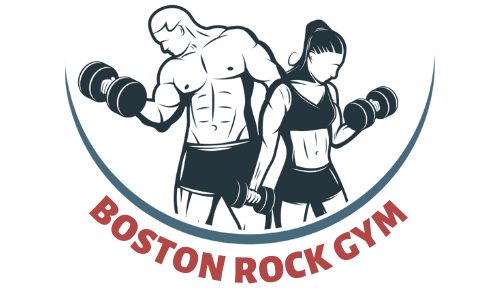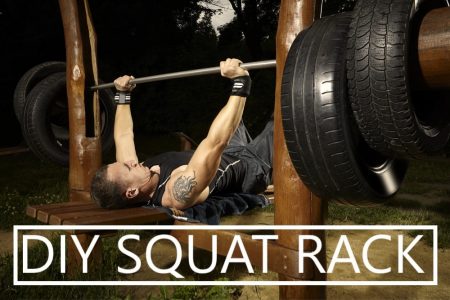A DIY Squat Rack is an excellent choice if you are low on budget and can’t afford a ready-made one. It’s also a reasonable option if you can’t afford a gym membership.
Either reason, you will end up with a home-based power rack which is one of the most essential gym equipment you can have.
One interesting fact about a home-based DIY squat rack is that; it affords you the liberty to work out whenever you feel like. Its constant presence is a daily reminder that you need to level up with consistency to achieve your body goals.
Contents
What is a Squat Rack?
A squat rack is a piece of gym equipment designed to enable athletes and even an average Joe perform squats effectively. Squat racks vary in size and they come in a box-like form with four erect posts.
Two horizontal bars rest on each side of the four erect posts as opposed to each other.
These horizontal bars are built to hold the free weight Olympic barbells or heavyweights used for the squat exercise.
They are also called horizontal safety bars and are flexible for easy adjustments. A squat rack is also called a power cage or power rack.
It is like a workstation or work confinement for anyone performing the squat exercise. It’s useful at home and at the gym.
How to Build a DIY Squat Rack
Materials Required for a DIY Squat Rack Project
- 8 pieces of 4×4 wood. 8 inches long each.
- Steel ties, 3×5, 8 pieces
- Bit wood screws. Get them in 2 and 3 inches. A pound should be enough
- Drill bit, 1/8 inch
- Steel ties, 14 of them in the dimension 1/2x2x2 3/4. They should be at an angle of 90 degrees.
Safety bars
- Two Caps
- Two 60 Inch Pipes
- 90 Degree Elbows. Two of them
- Two 4 Inch Pipes
Pull Up Bar
- 60 Inch Pipe
- Two Caps
3 by 4-inch pipe list
Pins for racking :
- 3 or 4 half-inch pipes
- 2 caps
- 2 – Chair Flanges2 – 1
- 1/2 Inch Pipes
- 2 – Pipe Connectors
Tools Required
- Screwdriver
- Brush
- Power drill
- Hammer
- Tape
- Technical meter rule
- Hand saw
- 2 “Copper nails
Step 1: Mark the full length of the four planks that will stand vertically to form a square shape. The markings should be done at the center of each plank and should be straight. Use your meter rule to achieve this.
Step 2: Drill the markings to create holes for j-cups as well as spotter arms using a drill press.
Step 3: Ensure the holes are clean. Use sanders to obtain a smooth hold for the spotter’s arms.
Step 4: Put the four vertical boards in place on the plain floor. Place them according to the size you want. If you are much broader in size, you will need to space the boards to have a spacious enclosure.
Step 5: Measure the distance between the four vertical boards and ensure they are the same. Use tape for this purpose. With the measurement, cut the remaining woods which will be used to complement the vertical boards horizontally.
Step 6: Make cross pieces with the help of your saw to brace up the posture of the squat rack. You need to make 6 pieces of 4-foot cross pieces and leave some to be used for the bottom – 45 degrees each.
Step 7: Now you can assemble your squat rack together. With the four vertical boards in an upright position and all braced-up, use your screws to assemble the rack as one piece – adding the horizontal boards to their vertical counterparts.
Step 8: Now fasten the cross pieces into the top and bottom of the vertical wood (at the point where they meet with the horizontal boards) using your 2″ copper nails and hammer or better yet, screw them in. The steel ties can be deployed to the corners for assembling.
You will have a rigid structure afterward owing to the cross pieces serving as braces.
Your DIY squat rack should be ready to serve its purpose after all these.
Here are helpful videos to assist you with the process:
Note: Don’t be reluctant to ask for help if you need any. A friend, relative, or spouse can assist you.
They should come in handy especially when you need someone to hold the boards while you assemble them together. Don’t try to do it alone.
DIY vs Ready Squat Rack
Comparing both squat racks, 3 major factors will be considered;
- Cost
- Quality
- Durability
Let’s begin with the first
Cost
Naturally, the ready squat rack leads. This is based on the machinery, logistics, and technical know-how deployed in the manufacturing process.
The ready squat rack most times is twice the price of a DIY. And frankly, price is the ultimate factor when buying good equipment so it can’t be overlooked.
For those who can afford it, price is not an issue. But for those on a budget and still want the good stuff, this steep price comes as a challenge.
However, they can always look the other way – the DIY way.
Quality
Constructed from the finest of materials and finished to taste, the ready squat rack reflects the premium quality. This is sheer indisputable.
On the other side, the DIY version made of wood mostly is seen as substandard. However, that’s not entirely true. With the right quality of wood, you can have a resilient and sturdy power rack.
After all, prior to the advent of wrought iron, wood has served numerous purposes (power rack inclusive).
Suffice to add that it did a laudable job while it lasted and will still perform well even now that it is considered moribund.
Durability
In terms of durability, wrought iron (ready) will last longer than wood (DIY). However, if the said wood is maintained to the latter, it could match up to the durability of its counterpart.
Conversely, if the wrought iron is not maintained regularly, it’s durability potentials will be shortened.
Consequently, maintenance is a determining factor in the durability of both squat racks.
Why a Squat Rack Need?
Here are a few reasons why a DIY Squat Rack is to be considered an option.
For the Handy and Creative Minds
As far as DIY’s go, they are essentially top preferences for people who love to go handy on things. It sparks up this creativity in them and the feeling at the end of the project is priceless.
Let’s all admit; it’s a great feeling beholding the work of your dear hands. However, if you are not handy and creative, this is not a call to back out.
You can always learn and get your creative juices flowing. Think of it as an exciting new experience and you’ll enjoy every bit of it.
Cost
Another foremost reason to answer the “Why” question narrows down to budget. A DIY squat rack will be less expensive relative to a ready-made one.
A gym membership will also be difficult to maintain for someone on a tight budget.
You can achieve your body goals without having your finances battered.
Preference
Choices will always be a decisive factor as far as buying and selling endure. Some people just love the rustic side of life and detest metals.
Sounds strange but true. DIY projects make use of wood more than metals. The choice is understandable.
Wood is easier to cut, shape, maneuver, and get the desired end product. If you love a wooden squat rack, doing it yourself will be awesome.
Customization
One fine aspect of a DIY project is that you can bespeak it. Are you are short, tall, slim, or fat? no shape is bad.
You can tailor your squat rack to suit your body frame rather than sizing them up at a gym equipment store.
The fact that its wood makes it more convenient to have a custom-made squat rack.
Benefits of Using a Squat Rack
As one of the fundamental gym equipment designed to keep the body fit, squat racks come with a handful of benefits which include:
Safety – With the horizontal safety bars that are adjustable, you can perform your squats safely.
Just set them at heights you are comfortable with so you can safely rest the barbells on them when you are tired.
Unique Workplace – With a squat rack, you have a designated workstation to carry out your exercises.
This makes your training serious and professional. With a special workstation, you reduce interruptions from passersby.
Multipurpose Usage – With this ideal workstation, you’re not limited to just squats, you can also perform bench presses, rack pulls, heavyweight lifting, and more.
The problem of Using a Squat Rack
Using a squat rack sure sounds like a great idea – benefits inclusive. This does not go without saying that it comes with some cons – one actually.
Your ability to train naturally is hampered in that workstation you call power cage.
You see, learning how to squat naturally, gives you the liberty to practice from scratch.
After you’ve improved remarkably, the squat rack is a fuel to help you accelerate.
Learning to squat with that cage will get you adapted to it and in its absence, you can hardly squat effectively.
So what’s the way forward?
Before jumping into the power rack train, ensure you’ve been squatting naturally and you are improving.
It’s better to carry your own weight first before adding the barbells.
Learning is progressive. You start from the bottom and work your way to the top, not from the middle.
How Much Time Will it Take to Construct a DIY Squat Rack?
It all depends on the individual handling the project. On average, 5-6 hours will be enough.
If you use a helping hand, it could be less.
You can assign tasks like cleaning the holes to someone else while you saw the wood and make other arrangements. If you are alone, it could gulp 8 hours or more.
So it’s okay to use some help, especially family. You could involve your kids if you have and turn it into a fun-filled family version of carpentry.
How Much Does it Cost to Build a DIY Squat Rack?
The price here will vary depending on the kind of squat rack you are constructing.
If you decide to build a simple Squat Rack for the sole purpose of squats, then your budget should be around $120 to $200.
However, if the activities in your squat rack will include lifting barbells and another heavyweight exercise, you will end up spending more.
This is because you have to find the best sturdy wood to contain the weight of your heavyweight equipment. You will also need to construct an extension on the planks to hold the plates of your barbells on both sides.
This additional requirement could see the price hike up to $250 or $300.
The materials you will employ in the construction can also affect the cost.
Some people don’t trust woods though they are quite rigid. They opt for metal pipes instead which are more expensive.
Using metal pipes will definitely increase the cost of your squat rack. Overall, a homemade squat rack cost can range from $120 to $300 based on the above points.
How to Maintain your Squat Rack
With a good maintenance culture, your homemade squat rack will stand the test of time and even hang on while you are gone.
Maintenance here is no big deal. One challenge with anything wood is insect attack which will cause it to deteriorate rapidly.
To avoid this, at the point of wood purchase, ask for the best oil or paint for wood coating.
Since they are wood dealers, they’ll certainly know about moths and how infamous they are for eating away at woods.
They will also know the best recommendation to offer you. After the construction, paint the entire squat rack with the oil or paint.
There are recommendations on the frequency of this coating. Some could be once in 3 months, some once in 6 months. Just follow the recommended frequency.
And as a rule of thumb, water and wood aren’t best of friends. Locate your squat rack in an area that rarely welcomes liquids.
The floor should be dry at all times. If there’s a water spillage by error, ensure you clean it up pronto and take the wood aside to dry a little.
Verdict
The verdict on DIY vs Ready Squat Rack is a conditional one since both are great and will serve their purpose well. It is based on the following conditions:
Condition 1: DIY is the best option if you run a shoesize budget otherwise, a ready-made option.
Condition 2: You can still go for a DIY If you want simple equipment for just squats and you don’t want to spend much though you have the money for it.
Condition 3: The ready squat rack is great if you are an Olympic weight lifter. You need all the metal sophistication and structural rigidity of a ready one for your sport.

Working out is my life. I love to help others see the potential of their bodies as they transform into their best selves.

